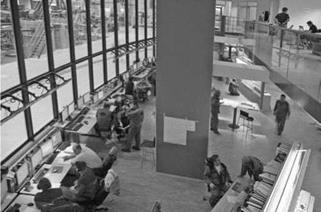Stora Enso is an integrated paper, packaging, and forest products company based in the west of Sweden.* The group has 46,000 employees in 40 countries. In 2005, Stora Enso made total sales of €13.2 billion. Founded at the end of the nineteenth century, the company now exports 85% of its production. With a production capacity of 1 million tonnes annually, the company’s paper mill is one of the largest in the world. Stora Enso’s paper mill has a thoroughly developed control room that is impressive for its merging of environmental design and architecture. Stora Enso regards fundamental design as important. The company has thus expended much effort on its organisational design with a matching architectural design.
The control room is an integrated feature of the papermaking process and has been designed in such a way that, although physically separate from the manufacturing area, it seems to be a part of this facility. This is achieved by aligning the ceiling height of the control room with the ceiling height of the paper mill hall. The high ceiling height and the ceiling height compatibility encourage the operators not only to feel physically part of the paper mill but also psychologically so. This design makes the environment amenable to operator control of the manufacturing process, while allowing verbal communication between the operators in their work. Sensitive design has reduced to a minimum the ambient noise and vibration. This has been achieved by the use of double glazing, and special locks and door-opening mechanisms. Excessive noise and air pollutants are thus prevented from entering the control room. A specially constructed floor neutralises vibrations from the adjacent manufacturing area and prevents vibrations from disturbing the control room work and its electronic equipment. Similarly, lighting design is rather sophisticated. All lighting is glare-free. The positioning and direction of lighting fixtures add to the psychological feeling of that operators and their work environment are a part of the paper mill hall. Furniture design, including chairs and desks, and the positioning of displays all meet reasonably good ergonomics standards.
A key feature of Stora Enso’s organisation design is the support of control room operators who are ‘all-rounders’ and skilled in multitasks. Specialisation is avoided as much as possible, as this restricts an operator’s skills and competencies. Control room operators are obliged to work both in the control room and out in the paper mill. Their work tasks encompass process servicing and some aspects of maintenance and repair work. Control room operators are well-educated engineers; currently, they are discussing the need to employ some specialists in information and communication technologies (ICT). In this high-tech environment, supervision, maintenance, and development of information technology (IT) are of increasing importance.
Control room operators are also involved in development work. To a large extent this type of work is done in meeting rooms that are an integral part of the control room. Stora Enso also provides continuous training in different job-related areas. Although continuous learning is an everyday feature of the operators’ work, there are no special simulation facilities in the existing control system. The computers that
|
FIGURE 8.10 Overview of the ‘high ceiling’ control room at Stora Enso. |
are part of the process control system are not directly used in any systematic way for training and development.
An area for future improvement is the lack of availability of large-scale overview displays. Today the operators use static, paper-based drawings of the whole process (observable in the right-hand background in Figure 8.10). Stora Enso has investigated this possibility but say they are unable to identify any suitable products currently available. As soon as the market can offer some good solutions, they plan to develop large-scale overview displays for their own purposes.




